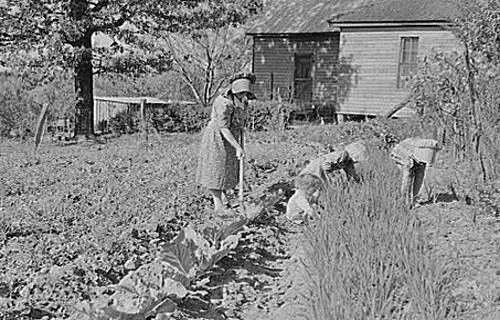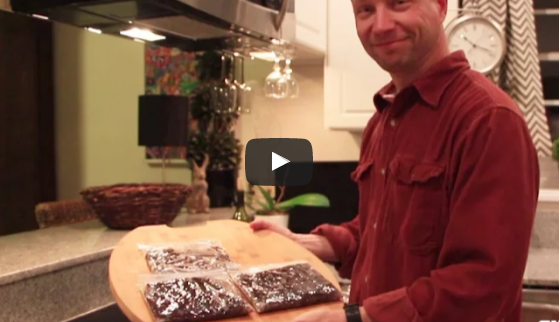During the winter months, pioneers did their best to keep warm. They would keep the fire in their log homes going all day and wear warm clothes made of flannel and wool. But what did they eat? Is too cold in the winter to grow fresh fruits and vegetables, so pioneers needed to find a way to make their crops from the summer last through the winter months.
Generations ago, it was not so easy to function during the winter. Survival was anything but guaranteed.
People had to take extreme measures just to get through the cold and snow for months out of the year.
How people survived the winter, from the Middle Ages to the last century, might surprise you.
The techniques used to maintain fresh apples, carrots, potatoes, pumpkins, and even cabbage were part of every homesteader’s winter survival arsenal until new growth became available in the spring.
Saving fruits and vegetables for winter use was a way of life for the old-timers, and it is not that difficult for the modern gardener to do the same. There are five simple points to follow if you want to be eating your fresh produce when the winter storms are swirling outside.
When to harvest
The first consideration is to choose when you harvest. Harvesting vegetables like potatoes, rutabagas, turnips, and fall varieties of cabbage, onions, and garlic while summer temperatures are still dominant will lessen the hardening process in the tissues and lower their keeping qualities compared to those harvested in later fall.
Do not wait too long, though. If the fruit is a squash or zucchini which can be damaged by hard frost, it should be harvested before temperatures dip below -1º C. Some vegetables, such as potatoes, are deep enough in the ground that a later harvest is possible, as frost will take some time to reach the tubers.
Ripeness is also a factor. A ripe fruit is unlikely to survive months of storage, whereas fruit that will ripen in storage will last longer. Pioneers specifically grew late-maturing varieties to extend storage times. Winter apples such as the Herb Schmidt, Red Rome, and Cortland varieties are designed to store well and not ripen until mid- to late winter.
Having chosen intact fruits and vegetables, the third point is to ensure that the material is clean and you are not storing earwigs, spiders, earthworms or other wildlife along with your fruit or vegetables. Insects and their larvae can both damage your stored materials and act as decomposition points when they die.
Pickling: Pickling means placing something in vinegar and spices to make it last longer. The vinegar helps stop germs from getting to the food and making it rotten. The pickles we see at the store are pickled cucumbers, but you can pickle almost anything, such as peppers, nuts, melons, cherries, and tomatoes. Can you guess what pioneers called pickled tomatoes? Ketchup! We still eat pickled tomatoes today!
Modern-day Native American cuisine is varied.The use of indigenous domesticated and wild food ingredients can represent Native American food and cuisine.North American native cuisine can differ somewhat from Southwestern and Mexican cuisine in its simplicity and directness of flavor. The use of ramps, wild ginger, miners’ lettuce, and juniper berry can impart subtle flavours to various dishes. A chef preparing a Native American dish can adopt, create, and alter as their imagination dictates.
Drying: Pioneers would hang food up to dry. Taking the moisture out of the food helps make it last longer. Pioneers would string foods up close to the fire where the heat from the fire would help dry them out, or they could place some food outside, and the heat from the sun would dry things out. Some foods pioneer could dry include apples, pumpkins, pears, and grapes. Dried grapes are called raisins!
On a really sunny day, you can dry apples without the oven. Set your trays of apple slices in a very sunny place and lay cheesecloth over the slices to keep the bugs off of them. The apples may have to be in the sun for a day or two to dry completely. (If you are drying the apples outside in the sun, bring them in at night and put them out again the next day.)
The next step for winter storage of fresh fruits and vegetables is to find a suitable storage area with conditions that prevent fungal and bacterial growth. Decay organisms do not grow well under conditions that are too cool, salty, acidic, or dry for them to multiply rapidly. For fresh fruits and vegetables, a dry, well-ventilated location with temperatures below 6º C provides ideal storage conditions. In the early 1900s, root cellars were built into sidehills or in well-drained ground at depths below the frost line, where temperatures hovered close to 3 to 6º year-round.
A grand encyclopedia of country Carnivore’s Bible , weather wisdom, country remedies and herbal cures, cleaning solutions, pest purges, firewood essentials, adobe making and bricklaying, leather working, plant dyes, farm foods, natural teas and tonics, granola, bread making, beer brewing and winemaking, jams and jellies, canning and preserving, sausage making and meat smoking, drying foods, down-home toys, papermaking, candle crafting, homemade soaps and shampoos, butter and cheese making, fishing and hunting secrets, and much more.Carnivore’s Bible : Traditional Skills for Simple Living
Most of us do not have root cellars, but if you have a basement, then a corner under the stairwell or along the north wall might be cool enough for good storage. The coldroom in the northwest corner of my basement, complete with insulated walls, stays well below 8º all winter. A spare refrigerator (plugged in) can also act as a cold storage facility for root vegetables like potatoes and carrots. I have had trouble storing cabbages in a fridge but others have reported good results. I prefer to hang the cabbage heads upside down in a cool, ventilated area.
There are also options for pit storage outside, with produce being put into the ground and covered with hay or other insulating materials. This was historically an effective method for storage in the colder, drier northern interior (pits were often built underneath the cabin itself), but, unless the pit is carefully located and protected from rain and runoff, it is a less successful method for the inland valleys of the North Coast.
In the last days before winter when plants are retreating into dormancy, the closure of gardens does not need to be the end of fresh produce. Although pickling, freezing, and canning are effective techniques for preserving food, the reduction of vitamins, especially Vitamin C, during these preservation methods can make saving fresh produce important for local food users who prefer home-grown produce. All you need is a dry, cool, moisture-free environment for good storage, and quality fruits and vegetables properly prepared for winter use.
A last word about preserving food in the ground
Although the above methods are used to preserve vegetables, some also used them to preserve meat such as jerky. The main thing to keep in mind when using these methods to preserve food in the ground is to keep favorable environmental conditions to prevent food spoilage. The concept of preserving food in the ground is similar to having an improvised root cellar. You need to have a favorable humidity and temperature and keep the storage space cool and dry. Also, you should make sure that rodents and other pests are kept away. By using the information provided here, you will be able to enjoy your preserved foods at their peak of flavor, without using modern methods of preservation. You don’t need electricity or a state of the art root cellar to preserve your food if you chose the natural storage method.
Root cellar: A root cellar is like a man made cave. Pioneers would dig into the side of a hill, and place some foods like root vegetables, underground.
Root vegetables are foods where people eat the part that grows under the ground such as potatoes, carrots, beets, and onions. The root cellar would stay about 50-60 degrees all year round, keep the vegetables from getting too hot or too cold. Pioneers would start preserving their food as soon as possible in the summertime to make sure they had plenty to eat during the winter. They would store these foods upstairs in their attics or keep them in the root cellar.
For potatoes, there are two schools of thought: some of the old commercial potato farmers in the Terrace area stored their potatoes with the dirt brushed off but the tubers unwashed. I personally like to wash my potatoes, having found that lumps of dirt on the potatoes can act as decomposition points.
Cleanliness should also mean removal of leaves and stems from vegetables, as these materials rot faster than the thicker-skinned taproots or tubers. Even leaves on fruits such as tree fruits and squashes will act as decay points. When apples were shipped from the Skeena Valley orchards in the 1930s, the fruits were wrapped in tissue before being packed into boxes so that even the skins of the apples did not touch each other.
They Threw Every Bit of Food (Even Fruit) Into Stew
When it was too cold to till the fields from September 29 to February 2 in the Middle Ages in Russia, people would survive on stew. They would make a pottage of boiled vegetables and grains, and put every type of food they had into it.
They would even throw fruit in, since they thought it was unhealthy to eat raw fruit. Villagers would include cheese and eggs as well, while members of the upper class would eat it with pigeon, butter, figs, cheese, grapes, red wine, and mutton.
One of the interesting sources of winter greens in the early 1900s was the use of forced greens from taproots or bulbs. For example, dandelions successfully grow in moist sand. The young leaves are quite edible and full of Vitamin C. Beets can be forced in the same fashion, as well as young onions and garlic. Cut back the tops to 2 to 3 inches and plant so the moist sand is slightly below the top of the taproot or bulb. Place in a dark, cool corner and harvest throughout the winter. In February you can bring your mini-greens garden to the light of a south-facing window.
Natural preservation
This process involves leaving the vegetables in the ground and it’s also known as late harvest. It’s quite simple and you don’t have to pick the vegetables and move them to another location. Everything is done on the spot, in the garden.
Chicory and Escarole
What you need for this method to work:
planted chicory and escarole,
dried ferns or straw
two boards of the same length as the planted rows
a few thin wooden strips or branches
plastic sheeting
Instructions:
Before the severe cold, around November, sink the edges of the boards along the outer length of the planted rows to enclose them. Top the boards with branches or wooden strips and then with a bed of dried ferns or straw. Cover the entire structure with a sheet of plastic and make sure gutters don’t form on the fern layer.
Preserving Cabbage using the Trenching Method
What you need for this method to work:
Cabbage
Soil
Straw or ferns
Instructions:
Dig trenches 8 inches deep by 8 inches wide, running in an east-west direction. Place the cabbages side by side, stems resting on the edge of the trench, on the south side. The heads should be resting in the trench. Cover the stems with the soil you dug out and cover the heads completely with straw or ferns.
Smoking Meat and Fish
Smoking was another fairly common way to preserve meat, especially fish and pork. Meat would be cut into relatively thin, lean strips, immersed briefly in a salt solution and hung over a fire to absorb the smoke flavoring as it dried — slowly. Occasionally meat might be smoked without a salt solution, especially if the type of wood burned had a distinctive flavoring of its own. However, salt was still very helpful because it discouraged flies, inhibited the growth of bacteria, and hastened the removal of moisture. When you are canning meat products remember these things.
Why should I can my own meat?
If you’ve ever tried to buy food in bulk but realized you don’t have nearly enough freezer space, you’ll find that canning your own meat can be great for storage. There’s no need for freezing or refrigeration. Canning can also be great for when you want to give away food as gifts during the holidays.
Books can be your best pre-collapse investment.
Carnivore’s Bible (is a wellknown meat processor providing custom meat processing services locally andacross the state of Montana and more. Whether your needs are for domestic meator wild game meat processing)
The Lost Book of Remedies PDF ( contains a series of medicinal andherbal recipes to make home made remedies from medicinal plants and herbs.Chromic diseases and maladies can be overcome by taking the remediesoutlined in this book. The writer claims that his grandfather was taughtherbalism and healing whilst in active service during world war twoand that he has treated many soldiers with his home made cures. )
Easy Cellar(Info about building and managing your root cellar, plus printable plans. The book on building and using root cellars – The Complete Root Cellar Book.)
The Lost Ways (Learn the long forgotten secrets that helped our forefathers survive famines,wars,economic crisis and anything else life threw at them)
LOST WAYS 2 ( Wordof the day: Prepare! And do it the old fashion way, like our fore-fathers did it and succeed longbefore us,because what lies ahead of us will require all the help we can get. Watch this video and learn the 3 skills that ensured our ancestors survival in hard times offamine and war.)
Survival MD (Best Post Collapse First Aid Survival Guide Ever)
Conquering the coming collapse (Financial advice and preparedness )
Liberty Generator (Build and make your own energy source)
Backyard Liberty (Easy and cheap DIY Aquaponic system to grow your organic and living food bank)
Bullet Proof Home (A Prepper’s Guide in Safeguarding a Home )
Family Self Defense (Best Self Defense Strategies For You And Your Family)
Survive Any Crisis (Best Items To Hoard For A Long Term Crisis)
Survive The End Days(Biggest Cover Up Of Our President)


